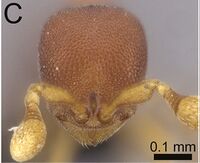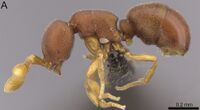Discothyrea athene
| Discothyrea athene | |
|---|---|

| |
| Scientific classification | |
| Kingdom: | Animalia |
| Phylum: | Arthropoda |
| Class: | Insecta |
| Order: | Hymenoptera |
| Family: | Formicidae |
| Subfamily: | Proceratiinae |
| Tribe: | Proceratiini |
| Genus: | Discothyrea |
| Species group: | traegaordhi |
| Species: | D. athene |
| Binomial name | |
| Discothyrea athene Hita-Garcia & Lieberman, 2019 | |
Discothyrea athene is known from various localities in East Africa including Rwanda, Uganda, Kenya, Tanzania, and Mozambique, where it occurs in forest and woodland, usually but not always below 1000 m. It has been collected in riparian forest, swamp forest, and near streams throughout its range, suggesting a possible preference for mesic habitats. The species lives in leaf litter.
Identification
Hita-Garcia and Lieberman (2019) - The following character combination distinguishes Discothyrea athene from the remainder of the Discothyrea traegaordhi species complex:
- standing pilosity absent from mesosoma and abdominal terga
- propodeum denticulate
- eyes present, relatively large (OI 5–9)
- in dorsal view mesosoma relatively broad and robust (DMI 59–67, DMI2 92–100)
- mesotibia without apicoventral spur
- petiole attenuated dorsally (DPeI 300–500, LPeI 286–500)
- sculpture distinct, declivitous face of propodeum foveolate
- generally smaller species (WL 0.30–0.53)
- color usually orange, variably infuscated
This species is relatively unspecialized in character states but can only be confused with the potentially sympatric species from East Africa possessing a robust and stocky mesosoma (LMI2 92–103), such as Discothyrea damato, Discothyrea wakanda, Discothyrea schulzei, or Discothyrea venus. However, the latter is unique by having AT4 around 1.6 to 1.8 times longer than AT3 (ASI 158–183), and D. schulzei and D. wakanda have noticeable standing pilosity on the mesosomal and abdominal dorsa. The closest species is D. damato, but both can be differentiated by the eye size, the shape of petiole, and abdominal proportions.
Discothyrea athene varies geographically in size, with specimens from Uganda and Rwanda being generally larger (HW 0.38–0.42; WL 0.45– 0.53) than those from Kenya, Tanzania, and Mozambique (HW 0.33– 0.39; WL 0.38–0.50). This variation in size is not related to elevation. There is also some variation in color which may correspond to distribution: most individuals are similarly orange, while those from Rangiro are notably darker. The degree of attenuation of the petiolar node is also quite variable (DPeI 300–500; LPeI 286–500) but does not seem to be correlated to geography since specimens from the same series display pronounced differences.
Keys including this Species
Distribution
Latitudinal Distribution Pattern
Latitudinal Range: 0.85617° to -19.03298°.
| North Temperate |
North Subtropical |
Tropical | South Subtropical |
South Temperate |
- Source: AntMaps
Distribution based on Regional Taxon Lists
Afrotropical Region: Kenya, Mozambique, Rwanda, Uganda (type locality), United Republic of Tanzania.
Distribution based on AntMaps
Distribution based on AntWeb specimens
Check data from AntWeb
Countries Occupied
| Number of countries occupied by this species based on AntWiki Regional Taxon Lists. In general, fewer countries occupied indicates a narrower range, while more countries indicates a more widespread species. |

|
Estimated Abundance
| Relative abundance based on number of AntMaps records per species (this species within the purple bar). Fewer records (to the left) indicates a less abundant/encountered species while more records (to the right) indicates more abundant/encountered species. |

|
Biology
Castes
 X-ray micro-CT scan 3D model of Discothyrea athene (worker) prepared by the Economo lab at OIST.
X-ray micro-CT scan 3D model of Discothyrea athene (worker) prepared by the Economo lab at OIST.
See on Sketchfab. See list of 3D images.
Nomenclature
The following information is derived from Barry Bolton's Online Catalogue of the Ants of the World.
- athene. Discothyrea athene Hita Garcia & Lieberman, in Hita Garcia, Lieberman, et al. 2019: 31, figs. 4D, 6D-12D, 14D, 25, 26 (w.) UGANDA, KENYA, MOZAMBIQUE, RWANDA, TANZANIA.
- Type-material: holotype worker, 4 paratype workers.
- Type-locality: holotype Uganda: Kibale Nat. Park, Kanyawara Biological Station, 0.56437, 30.3605, 1510 m., FHG01060, 6-16.viii.2012, rainforest, leaf litter (F. Hita Garcia); paratypes with same data.
- Type-depositories: BMNH (holotype); CASC, MHNG, SAMC, ZFMK (paratypes).
- Distribution: Kenya, Mozambique, Rwanda, Tanzania, Uganda.
Unless otherwise noted the text for the remainder of this section is reported from the publication that includes the original description.
Description
Worker
(n = 17) EL 0.03–0.04; HL 0.39–0.49; HW 0.33–0.42; SL 0.19–0.26; PH 0.19–0.27; PW 0.23–0.32; PrH 0.23–0.30; DML 0.23–0.34; WL 0.38–0.53; HFL 0.21–0.30; PeL 0.04–0.07; PeW 0.15–0.21; PeH 0.15–0.20; LT3 0.27–0.39; LT40.25–0.33; OI 5–9; CI 80–89; SI 48–53; LMI 47–51; DMI 59–67; DMI2 92–100; ASI 85–103; HFI 53–60; DPeI 300–500; LPeI 286–500.
Head fairly broad (CI 80–89) and round, posterior head margin gently convex; posterodorsal corners of head broadly rounded; in frontal view, sides of head convex and tapering somewhat anteriorly; eyes present, relatively large (OI 5–9) and round, comprising several ommatidia, placed about a third of the way between anterolateral corner of gena and posterior head margin; eyes visible in frontal view; frontal lamella broadly triangular in profile, apex rounded; lamella with translucent basal region, variably developed, from an indistinct patch to an elliptical and well-defined fenestra; medial clypeus convex, lateral clypeus curving gently between antennal sockets and anterolateral corners of head, bearing short, curved setae. Antenna with short scape (SI 48–53), scape strongly incrassate, slightly bent; pedicel subglobose, broader than long; true antennomere count nine; apparent antennomere count seven to nine; flagellomeres basad apical club highly compressed, taken together only about as long as apical club. Ventral head with postoccipital ridge weakly developed, without anteromedian carina; hypostoma medially rounded, arms somewhat narrowed, similar in width across their length; palpal formula not examined. Mandible edentate except for small, sharp prebasal denticle; basal angle broadly rounded; longitudinal carina on ectal face confluent with masticatory margin for most of its length, leaving small depressed triangular area anterad prebasal denticle.
Mesosoma gently convex, pronotum slightly lower than propodeum. In dorsal view mesosoma broad, robust (DMI 59–67; DMI2 92–100), somewhat narrowed posteriorly, pronotum wider than propodeum; pronotal humeri moderately rounded; posterior propodeal margin concave, distinctly concave between dentae; posterodorsal corners of propodeum angulate to dentate, teeth blunt but distinct; declivitous face of propodeum distinctly concave in profile and oblique posterior view; propodeal spiracle relatively large, subcircular, directed posterolaterally, often conspicuous due to shiny, unsculptured spiracular opening; propodeal lobes short, rounded.
Legs short to moderate in length (HFI 53–60) and slender; mesotibia without apicoventral spur, with small but distinct seta inserted in apical pit; mesobasitarsus short, about as long as tarsomeres II-IV taken together.
Petiolar node moderately to strongly attenuated dorsally, about 3.7 times higher than broad (LPeI 286–500). In profile, anterior face of node convex, apex broadly peaked, posterior face sloping posteroventrally. In dorsal view, petiole about 3–5 times wider than long (DPeI 300–500); sides divergent posteriorly, posterior margin slightly concave, anterior margin nearly straight. In anterior view, petiolar outline very wide, pentagonal, edges and apex slightly rounded but distinct; in oblique anterior view, anterior face flat; in ventral view approximately rectangular, sides diverging posteriorly; subpetiolar process large, lobate, apex rounded; petiolar spiracles reniform in ventral view.
Abdominal segment 3 roughly campaniform, tergite prolonged anteriorly pasted anterior sternal margin, tergite widest just anterad end of segment, sternite sloping to convex in profile; AS3 with scarce trace of medial carina; prora present as a very fine carina, shallowly concave in ventral view; AT4 about 0.85 the length of AT3 to slightly longer, usually approximately equal in length (ASI 85–103); AT4 almost perfectly hemidemispherical; AS4 with anterior lip short but fairly broad, covering more than the one-third of the width of AS3, anterior margin straight; successive abdominal segments short, telescopic, often concealed.
Sculpture on head, dorsal mesosoma, and petiole regularly punctate-reticulate or foveolate-reticulate; on ventral head surface and lateral mesosoma becoming foveolate to punctate; lateral mesosoma with interspaces of foveolate forming rugulae, especially on lower surfaces; declivitous face of propodeum shallowly foveolate-reticulate to laterally rugulose; mandibles with fairly coarse piligerous punctae; frontal lamella and medial clypeus roughly granulate; AT3 shallowly punctulate-reticulate; AT4 with minute, dense piligerous punctulae, clearly shinier than AT3.
Setation mostly consisting of very fine, appressed white pubescence, similarly distributed on dorsal surfaces, dilute to absent on lateral surfaces of head and mesosoma; abdominal sternite 3 with longer, curved decumbent white setae; abdominal segments five through seven with longer, flexuous standing setae; appendages with only very fine, appressed white pubescence; ectal face of mandible with curved, appressed to decumbent setae; row of straight, stout setae on masticatory margin.
Color unicolorous luteous-orange to brown, usually brownish orange, upper surfaces often slightly infuscated.
Type Material
See the beginning of this ("Nomenclature") section for detailed information about the specimen types. A cyber-type of the holotype is also available. This includes: Volumetric raw data (in DICOM format), 3D rotation video, still images of surface volume rendering, and 3D surface (in PLY format) of the physical holotype (The Natural History Museum:CASENT0764088) in addition to stacked digital color images illustrating the head in full-face view, plus profile and dorsal views of the body. The data are deposited at Dryad and can be freely accessed as virtual representations of the type. There is also a Sketchfab 3D surface model of the holotype. It is shown above, in the Caste section, and at Sketchfab (see the link in the Caste Section).
Etymology
The Greek goddess Athene was fabled to have competed against a mortal woman named Arachne, whom the goddess punished for her hubris by transforming her into the first spider. Although the trophic biology of D. athene specifically is unknown, the species is named in reference to the known arachnophagic habits of its congeners. Additionally, Athene is archetypically portrayed bearing a helmet and a spear, reflecting the notably thick cuticle and prominent sting of Discothyrea.
References
- Hita-Garcia, F., Lieberman, Z., Audisio, T.L., Liu, C., Economo, E.P. 2019. Revision of the highly specialized ant genus Discothyrea (Hymenoptera: Formicidae) in the Afrotropics with x-ray microtomography and 3D cybertaxonomy. Insect Systematics and Diversity 3(6): 5; 1–84 (doi:10.1093/isd/ixz015).
References based on Global Ant Biodiversity Informatics
- Hita-Garcia F., Z. Lieberman, T. L. Audisio, C. Liu, and E. P. Economo. 2019. Revision of the highly specialized ant genus Discothyrea (Hymenoptera: Formicidae) in the Afrotropics with X-ray microtomography and 3D cybertaxonomy. Insect Systematics and Diversity 3(6): 5:1-84.

